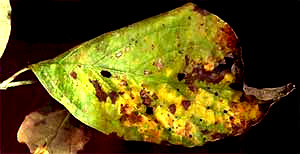(SOURCE: NCBI database)
KINGDOM: Fungi
DIVISION: Ascomycota
CLASS: Sordariomycetes
ORDER: Diaporthales
FAMILY: Gnomoniaceae
GENUS: Discula
SPECIES: destructiva
ON DOGWOOD
Right now a terrible disease is spreading through North America killing Flowering Dogwoods, both Cornus florida and C. nuttallii, which are among the most beautiful and treasured of tree species. The disease is caused by Dogwood Anthracnose Fungus, Discula destructiva, and the picture below shows the disease's symptoms.

Note the dark brown spots (dead tissue) surrounded by yellowness. In the disease's later stages the leaves are often red, as during the fall. The fungus kills by releasing a substance that breaks down the dogwoods' tissues into something the fungus can absorb and use for its own purposes. The fungus also releases toxins that kill tissue outright, and spread into the stem to infect new limbs and cause cankers.
The life cycle of Discula destructiva, introduced from Asia, is not fully understood. As of 2021, the sexual reproductive stage hasn't been reported. However, it's known that hyphae in leaf and twig tissue form microscopic "conidioma," which erupt through the tissue surface, often around the bases of hairs. In mass, they form a slimy, white to beige or pinkish ooze. They appear dark in the tissues of overwintered twigs. The conidioma asexually produce conidia-type spores, which carry the disease to other trees.
Since this disease is so important, there is plenty on the Web about it, such as at the CABI Invasive Species Compendium Discula destructiva page.